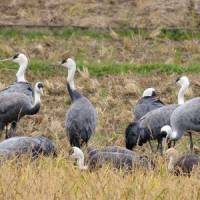About 300 hooded cranes have arrived in three prefectures in Shikoku since late October, a rare gathering of the birds outside the Izumi Plain in Kagoshima Prefecture that is drawing attention on whether Shikoku will become a new wintering spot for them.
The first arrival of cranes in Shimanto, Kochi Prefecture, in 2015 was confirmed on Oct. 28, and a number of them were spotted foraging for food in rice fields the following day. On Nov. 11, about 240 cranes were counted.
No more than 10 birds usually arrive in Shimanto, said Hiroshi Kimura, a member of a local crane protection group. "The cranes look nervous even while eating this year. They seem to be trying to figure out whether this place is good for wintering."
The arrival of some 300 birds on Shikoku was confirmed by mid-November, including cranes that flew to other places on the island such as Saijo in Ehime Prefecture and Kaiyo in Tokushima Prefecture, according to the Wild Bird Society of Japan and other groups.
Hooded cranes, designated as an endangered species, are bred in Southeast Siberia and Northeast China and fly to Japan, the southern part of South Korea and the downstream area of the Yangtze River in China in the fall as winter homes.
The number of arrivals in Japan has decreased sharply due to overhunting and reclamation of swamps. However, 90 percent of hooded cranes and 50 percent of white-naped cranes in the world now winter in the Izumi Plain because of local people's efforts to protect them.
More than 10,000 cranes fly to the plain annually, arousing concerns that many of them will die if an infectious disease occurs and that agricultural products may be damaged.
Given a series of infections with highly pathogenic avian influenza viruses in recent years, the Environment Ministry has been studying measures for decentralization from Izumi to other places such as Shunan in Yamaguchi Prefecture, fearing that the survival of the species could otherwise be threatened.
However, the plan has made little headway because the artificial creation of winter homes is extremely difficult if not impossible.
The massive arrival of cranes in Shikoku this year offers "rare opportunities" to achieve decentralization for wintering, said a ministry official in charge.
As cranes are nervous and highly guarded, conservation groups have asked the four prefectures in Shikoku, which also include Kagawa, to take measures not to scare them, such as restrictions on people approaching them and the use of hunting guns near them.
As to why the arrival of cranes in Shikoku has suddenly increased, Yutaka Kanai, chairman of the Japan Crane and Stork Network, pointed to changes in the quality of water in winter homes in China.
"Cranes that have newly flown to Japan may be looking for good places for wintering," he said.




